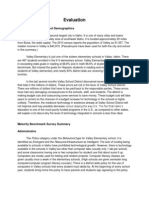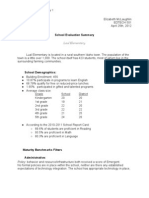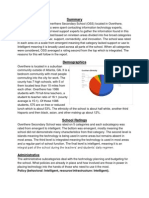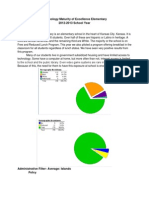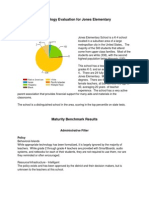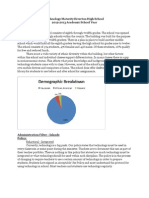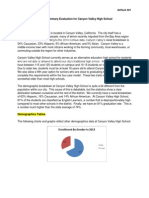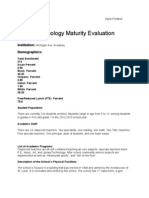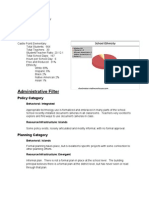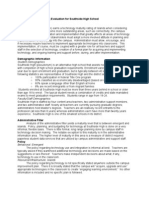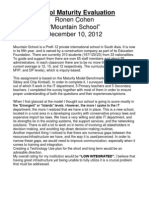School Evaluation
School Evaluation
Uploaded by
Ross EwingCopyright:
Available Formats
School Evaluation
School Evaluation
Uploaded by
Ross EwingCopyright
Available Formats
Share this document
Did you find this document useful?
Is this content inappropriate?
Copyright:
Available Formats
School Evaluation
School Evaluation
Uploaded by
Ross EwingCopyright:
Available Formats
The school I currently work for is in a suburban area of Qingdao, China.
This suburban area has a high concentration of Koreans, who roughly number 100,000 and make up the majority of the student population. While technically an international school, policies are more familiar to Koreans and Chinese. For example, students generally leave to a special academy after school to continue their studies, and sports teams are virtually non-existent. Being a private school, the students are of means. The families tend to fall into upper-middle and upper class. This is reflected in the number of smartphones, computers, and tablets the students have outside of school. Also, students have the advantage of small class sizes, with no more than 15 students per class. They also enjoy a student-to-teacher ratio of 8-1. This is in stark contrast to a Chinese public school, where 50 students per class is common. The school is 75% Korean, 15% Chinese, and 10% other (Japanese, American, Taiwanese, or of mixed heritage)
Ethnic prevalence
80% 70% 60%
50%
40%
30%
20%
10%
0% Korean Chinese Other
The Chinese staff, who makes up the large majority of the school, are licensed by the Chinese Ministry of Education. Most Chinese teachers have a masters degree, although subjects such as art and PE are not required to have the same level of education. Foreign teachers are generally not licensed, with some exceptions. Their nationalities vary, as do their years of experience. The pool of experienced international teachers is relatively small, so less stringent requirements are used. In general, all staff has over 3 years of experience and is between the ages of 25 and 35.
The teachers are 60% Chinese, 20% American, 10% Canadian, and 10% other (Filipino, Nigerian, European)
Teacher ethnicity
70%
60%
50% 40% 30% 20% 10% 0% Chinese American Canadian Other
Korean parents tend to be very involved in their childs education, and have created an unofficial PTA. The PTA meets with the administration roughly once a week, and discusses issues with the school and staff. Their concerns generally revolve around the foreign staff for multiple reasons. One is that they consider Chinese language an added bonus to their childs curriculum. This is because Korean parents place heavy importance on college acceptance, and Chinese language is not included in entrance exams. English is a critical component, and therefore are very interested in their students English progress. Further, foreign teachers in China tend to be relatively inexperienced, and watch the performance of the international staff relatively closely.
Emergent ADMINISTRATIVE Policy behavioral Emergent resource/infrastructure behavioral
Planning
Emergent
While instructors have access to a grading system, it is only for report cards. No training or development policy/programs exist. There is no software available for the school in terms of tracking progress, grades, attendance. Instructors are expected to design and use their own systems. While an informal plan existed for the creation of the school, there
Emergent resource/infrastructure Emergent Budget behavioral Emergent resource/infrastructure Administrative Information Emergent behavioral resource/infrastructure Emergent Island
has been no follow up policy for integrating new technology. Purchasing is not done on a plan basis, but by case-by-case needs Technology is not considered a budgeted item, and new resources are not planned or provided for. The school relies on its existing technology from the schools inception. Technology, while occasionally given important, is not on an equal basis with other items. More budgetary allowance is given to event planning, student performances, and marketing. Teachers can request access to paid sites, but it is reviewed on a caseby-case basis and is not included in any kind of budget. Instead, it is listed under miscellaneous needs. There is no administrative system to speak of.
CURRICULAR
Electronic Information
behavioral Emergent
resource/infrastructure Emergent Assessment behavioral Emergent resource/infrastructure Emergent
Curricular Integration
behavioral Island resource/infrastructure
Students and staff are rarely required to use electronic information resources, and accordingly rarely use them. A few subscriptions to paid online resources are available, but are used by 25% or less of the staff Limitations with computer access mean teachers tend to rely on physical resources rather than electronic ones. There is no electronic system to track grades or records. However, there are website subscriptions for electronic content Few staff and no students use technology for assessment. All is done through grading books No electronic tools exist/are used at the school for student assessment. Anything related to assessment is based in excel, and uploaded to a central database 2x a term Projectors are frequently used in class and the curriculum depends on that usage. Smart boards are available in every class, but are used infrequently and are independent of the curriculum (the curriculum does not require their use) As stated, projectors and smart boards are widely available. However, computers are rarely used or required. They also exist in a distant part of the school, leaving many teachers unwilling to access them.
Emergent Teacher Use behavioral Integrated
resource/infrastructure Emergent Student Use behavioral Emergent resource/infrastructure Emergent SUPPORT Stakeholder Involvement behavioral resource/infrastructure behavioral Emergent resource/infrastructure Emergent
Teachers utilize the smart board and website resources on occasional basis, mostly for the enrichment of content. This use is not regular and not part of an overall plan for its use in the classroom Teachers generally have access to technology, including said projectors/smart boards, computers, video cameras, and school wide Wi-Fi. Curricular based resources are available in most areas, particularly languages, as this is a bilingual school. Student use of school technology is very infrequent. In fact, student use is generally of their own mobile devices such as iPads and smartphones. Few students have regular access to computers and internet through school resources. Computer access is roughly once a week. No special student resources exist (websites, remedial programs, etc.) As there is no technology plan, relevant groups are not included. There are no heads of departments, so all requests/considerations are made by the individual teacher. Support is given to purchasing subscriptions, but no support for planning, implementing, and training of resources. No formal time or support is given to planning and implementation. Teachers are expected to use technology when and where appropriate. There are no training activities offered. If assistance is needed, the IT technician can assist, but only in Chinese. Further, this training is limited to hardware functionality (using the smart board, accessing the network, etc.) No training available Staff has access to formal and informal support for IT issues. The IT technicians are Chinese and not fluent in English, so translators are often required. Formal technical assistance is available throughout the day. An extra technician can be called in for complicated issues. Staff and students have access to school-wide, high speed Wi-Fi and use it often. Student access is more limited due to lack of computers.
Emergent Emergent
Administrative Support
Training
behavioral resource/infrastructure
Emergent Integrated
Technical/Infrastructure Support behavioral Integrated resource/infrastructure CONNECTIVITY Local Area Networking (LAN) Emergent behavioral
resource/infrastructure District Area Networking (WAN) behavioral resource/infrastructure
Emergent Emergent Emergent Emergent
However, students have the password and are able to connect using their own mobile devices, which they frequently do. As stated, high speed access is available throughout the school. As the school is private, there are no district/high level services available. Staff frequently uses the internet, but curriculum integration is limited. Elementary and middle school use it the least for integration, while high school uses it significantly more. As mentioned earlier, there is high speed Wi-Fi in all areas on the building, both for teacher and student access. Email and instant messaging programs are used for communication throughout all levels of the school. Important issues are communicated through multiple means including cell phone messaging systems. However, this is generally unrelated to curriculum or learning content Email is available to all staff, but students must create their own email through a free online service. New technologies, such as the above mentioned smart board, are generally accepted by staff. Chances for experimentation are limited however, and training is non-existent New technologies have been limited to the founding of the school. Smart boards and projectors have been readily accepted by the staff, but their use is still infrequent Technology is generally limited to those mentioned above, with overhead projectors and laptops. Technology utilization revolves around computers and projectors, with little use available to use.
Internet Access
behavioral Emergent resource/infrastructure Emergent
Communication Systems
behavioral resource/infrastructure Island
INNOVATION
New Technologies
behavioral Island resource/infrastructure
Comprehensive Technologies
Behavioral Resource/infrastructure
Administrative - Emergent The school is only in its 2nd year of operation, and operated at a loss its first year. Because of this, relatively little planning has been given to technology purchasing and implementation, either short or long term. The school purchased smart boards for every classroom and laptops for easy access in classrooms during its initial construction. Since then, the budget has not included any new technology or support materials to maximize their effectiveness. Further, there is no implementation plan for new technology. Generally budgetary items and policies are geared towards attracting new students.
Curriculum - Emergent The Chinese staff grew up and were educated by more traditional methods, and tend to rely on their use rather than implementing electronic resources and audio-visual materials. While PowerPoint presentations may be frequently used, hypermedia and internet resources are very infrequent. The foreign staff generally integrates technology into their curriculum to enrich content as opposed to teaching technology related skills. Assessment is done through physical grade books, and not viewable save twice a term when report cards are issued. Students have access to a computer lab, but it is always locked and special permission is needed.
Support - Emergent The school currently has relatively little in the way of support and resources. Budgetary concerns limit the amount of support offered to teachers. Planning is done from a top down perspective, with little input from teachers concerned. Parents and the board of directors have the largest say in planning, but rarely include technology into consideration. Training is completely non-existent. Teachers either need to learn on their own or resort to traditional methods of teaching. IT support, is relatively plentiful. Experienced technicians are available to help throughout the day, with specialists on call. Technical problems are usually resolved quickly.
Connectivity - Island
While the school is generally weak across the board, in the connectivity section there is more positivity. High speed, school wide Wi-Fi is openly available to all students and staff. While there is occasional down time, on a whole the system is very reliable. The school is also in constant search of ways to speed up access. Communication between the staff and administrators is done in a variety of ways, including instant messaging, emails, and free messaging applications on smart phones. Because there is no district, there are no district related resources.
Innovation - Emergent While the school began with special emphasis on technology, it has not sustained that drive. Since the schools inception, there have been no significant purchases towards technological resources. It is hoped that as the school increases enrollment, a larger budget will be allocated to technology and its acquisition. Conclusion The school abysmally fails when it comes to technology integration. There are a few reasons for this however. As said before, the school was operating at a loss, and given that its a for-profit school, investors must be willing to invest and see returns. Secondly, 98% of the students are Asian, which have different priorities than we may be accustomed to. Knowledge that can be tested on paper, entrance exams, and relatively rigid discipline are all given high priority among Asian parents and teachers. This does not easily lead to a constructivist classroom where technology and its applications have a chance to flourish. Finally, the school is brand new, and is still adjusting to the needs of parents and students, which are often difficult to maintain in a very competitive market (education is huge business in Asia) With that said, the purchase of smart boards was a relatively unique step in the area. Further, the school is considering the purchase of more computers, faster internet access, and other measures to embrace technology. These are all informal and nothing has been fully discussed however. My goal over the year is to introduce content among the staff to encourage use of resources found along the internet. Much of the staff, Chinese and foreign, are astounded by what Ive already introduced over the past few months. Hopefully, as the year progressed, teachers and students will embrace these resources, while finding and sharing their own.
You might also like
- Evaluation: Valley Elementary School DemographicsDocument5 pagesEvaluation: Valley Elementary School DemographicsangelabaezNo ratings yet
- School Evaluation Summary: DemographicsDocument9 pagesSchool Evaluation Summary: DemographicsroundyaNo ratings yet
- Evaluation of The Establishment As Compared To The Technology Maturity Model Lynn JohnsonDocument8 pagesEvaluation of The Establishment As Compared To The Technology Maturity Model Lynn JohnsonLynnDJJohnsonNo ratings yet
- Technology Environment Evaluation of Suburb High DemographicsDocument5 pagesTechnology Environment Evaluation of Suburb High DemographicsMatthew TaylorNo ratings yet
- School Evaluation Summary: ABC School District #321 DemographicsDocument8 pagesSchool Evaluation Summary: ABC School District #321 DemographicskjackimijNo ratings yet
- Evaluation Yanowsky VDocument5 pagesEvaluation Yanowsky VVirginia Yenter YanowskyNo ratings yet
- Evaluation PagliughiS 1Document9 pagesEvaluation PagliughiS 1Jacquelyn HeflinNo ratings yet
- Brian Mitchell - School Evaluation: DemographicsDocument5 pagesBrian Mitchell - School Evaluation: DemographicsBrian MitchellNo ratings yet
- Schulz Junior High School Evaluation Summary: Institution DemographicsDocument4 pagesSchulz Junior High School Evaluation Summary: Institution DemographicsRachaelle Larsen-GrimsrudNo ratings yet
- School Evaluation Summary: Laul ElementaryDocument5 pagesSchool Evaluation Summary: Laul ElementaryellimclaughlinNo ratings yet
- School and Student Description: Demographics (Based Upon Enrollment As of August 2012)Document8 pagesSchool and Student Description: Demographics (Based Upon Enrollment As of August 2012)tornduff0903No ratings yet
- Technology Maturity Evaluation Nathan de GrootDocument4 pagesTechnology Maturity Evaluation Nathan de GrootNathan Pete De GrootNo ratings yet
- School Summary Davis CDocument9 pagesSchool Summary Davis CClark DavisNo ratings yet
- School Evaluation Summary School Demographics: Behavioral: Integrated StageDocument6 pagesSchool Evaluation Summary School Demographics: Behavioral: Integrated StageMonica MachadoNo ratings yet
- School Evaluation Summary: AdministrativeDocument7 pagesSchool Evaluation Summary: AdministrativeellimclaughlinNo ratings yet
- Evaluation MillsC. 1Document4 pagesEvaluation MillsC. 1cmills26No ratings yet
- School Environment Evaluation Summary Rocko High School: AdministrativeDocument5 pagesSchool Environment Evaluation Summary Rocko High School: Administrativemarksmith11No ratings yet
- Technology Maturity Benchmark Evaluation DemographicsDocument4 pagesTechnology Maturity Benchmark Evaluation DemographicsjoshfizzleNo ratings yet
- Administrative Filter: DemographicsDocument4 pagesAdministrative Filter: DemographicsMike ProcykNo ratings yet
- School Evaluation Summary by Angela RutschkeDocument7 pagesSchool Evaluation Summary by Angela RutschkeAngela Weis RutschkeNo ratings yet
- Technology Maturity Evaluation: Institution: DemographicsDocument8 pagesTechnology Maturity Evaluation: Institution: DemographicsScott ChapmanNo ratings yet
- BF High School (BFHS) EvaluationDocument9 pagesBF High School (BFHS) EvaluationkathystricklandNo ratings yet
- Administrative: Policy (Behavioral: Intelligent, Resource/infrastructure: Intelligent)Document8 pagesAdministrative: Policy (Behavioral: Intelligent, Resource/infrastructure: Intelligent)danielmatthewsNo ratings yet
- School Environment Evaluation: Maturity Model Benchmark FiltersDocument5 pagesSchool Environment Evaluation: Maturity Model Benchmark FiltersCatherine HolthausNo ratings yet
- School Technology EvaluationDocument6 pagesSchool Technology EvaluationShannon States JohnsonNo ratings yet
- Virtual Success School DemographicsDocument8 pagesVirtual Success School DemographicstysonchaplinNo ratings yet
- School Evaluation SummaryDocument9 pagesSchool Evaluation SummarychrsitinesimmsNo ratings yet
- Demographics: Cow Pie HighDocument6 pagesDemographics: Cow Pie HighAmyEkoMorganNo ratings yet
- Technology Maturity of Excellence Elementary 2012-2013 School Year DemographicsDocument8 pagesTechnology Maturity of Excellence Elementary 2012-2013 School Year Demographicspuppeted85No ratings yet
- Maturity Model BenchmarksDocument7 pagesMaturity Model BenchmarksKathryn AverkampNo ratings yet
- Technology Environment Evaluation Summary For Towns High SchoolDocument11 pagesTechnology Environment Evaluation Summary For Towns High SchoolcjbushNo ratings yet
- Technology Maturity Riverton High School 2012-2013 Academic School Year DemographicsDocument7 pagesTechnology Maturity Riverton High School 2012-2013 Academic School Year DemographicsSarah SchneiderNo ratings yet
- School Evaluation: Downtown College AcademyDocument5 pagesSchool Evaluation: Downtown College AcademyjbcregerNo ratings yet
- School Evaluation DetailedDocument6 pagesSchool Evaluation DetailedNicole Emert ToppingNo ratings yet
- School Evaluation SummaryDocument4 pagesSchool Evaluation SummaryDessa SchurrNo ratings yet
- School: Global University Asia (GUA) Institutional DemographicsDocument5 pagesSchool: Global University Asia (GUA) Institutional DemographicsBeth RussellNo ratings yet
- AWebb Tech Use EvalDocument5 pagesAWebb Tech Use EvalAfton Rose ThompsonNo ratings yet
- Evaluation SalvatiJDocument6 pagesEvaluation SalvatiJJeffreySalvatiNo ratings yet
- Evaluation FletcherLDocument7 pagesEvaluation FletcherLLevi FletcherNo ratings yet
- The Role of Information Technology in Higher Education: Motivation and Enhancement of Student Learning Jumhur AKSU Ali Riza APIL Kenneth M. REYNOLDS Olcay KURSUNDocument9 pagesThe Role of Information Technology in Higher Education: Motivation and Enhancement of Student Learning Jumhur AKSU Ali Riza APIL Kenneth M. REYNOLDS Olcay KURSUNMuhammad FarazNo ratings yet
- Technology Plane ValDocument4 pagesTechnology Plane ValStacie Little BarkerNo ratings yet
- School Summary Evaluation For Canyon Valley High School DemographicsDocument10 pagesSchool Summary Evaluation For Canyon Valley High School Demographicsrichardjones3No ratings yet
- School Summary Evaluation For Canyon Valley High School DemographicsDocument17 pagesSchool Summary Evaluation For Canyon Valley High School Demographicsrichardjones3No ratings yet
- Maturity Benchmarks Survey SheetDocument4 pagesMaturity Benchmarks Survey SheetamlevangieNo ratings yet
- Technology Evaluation of Shindig Middle SchoolDocument7 pagesTechnology Evaluation of Shindig Middle Schoolrjackson7471No ratings yet
- Technology Maturity Evaluation: Institution: DemographicsDocument7 pagesTechnology Maturity Evaluation: Institution: DemographicsDana FredwellNo ratings yet
- Hillbilly Deluxe Junior-Senior High School: Administrative Filter: PolicyDocument3 pagesHillbilly Deluxe Junior-Senior High School: Administrative Filter: PolicyNateAddlemanNo ratings yet
- Evaluation CenigaTDocument6 pagesEvaluation CenigaTtraviscenigaNo ratings yet
- Evaluation of The Dolphin Secondary School: DemographicsDocument6 pagesEvaluation of The Dolphin Secondary School: DemographicsfabspringNo ratings yet
- Evaluation TsadiMDocument6 pagesEvaluation TsadiMmarytsadiNo ratings yet
- Student Type Sex: DemographicsDocument15 pagesStudent Type Sex: DemographicsTara PetersNo ratings yet
- Maturity Benchmark EvaluationDocument6 pagesMaturity Benchmark EvaluationfjkrugerrossNo ratings yet
- Technology Evaluation of T High SchoolDocument8 pagesTechnology Evaluation of T High SchoolCassidy BakerNo ratings yet
- Evaluation OsweilerRDocument4 pagesEvaluation OsweilerRryanosweilerNo ratings yet
- Institutional Demographics: Policy - Behavioral: Islands Resource/Infrastructure: IslandsDocument7 pagesInstitutional Demographics: Policy - Behavioral: Islands Resource/Infrastructure: IslandsJason AbateNo ratings yet
- Demographics For School "P": AdministrativeDocument7 pagesDemographics For School "P": Administrativesbh8812No ratings yet
- School Maturity Evaluation: Ronen Cohen "Mountain School" December 10, 2012Document8 pagesSchool Maturity Evaluation: Ronen Cohen "Mountain School" December 10, 2012ronentechNo ratings yet
- Demographics: School Evaluation SummaryDocument8 pagesDemographics: School Evaluation SummaryRosa A RosasNo ratings yet
- How To Get Smartphones Into Classes: a guide for teachersFrom EverandHow To Get Smartphones Into Classes: a guide for teachersNo ratings yet
